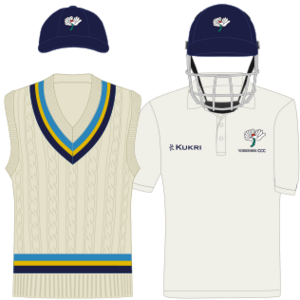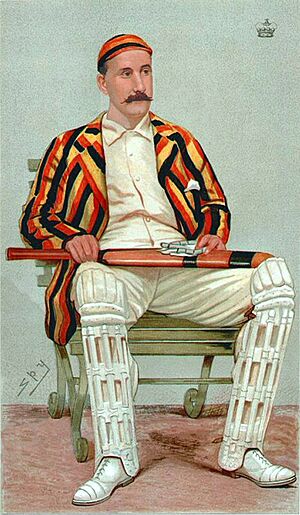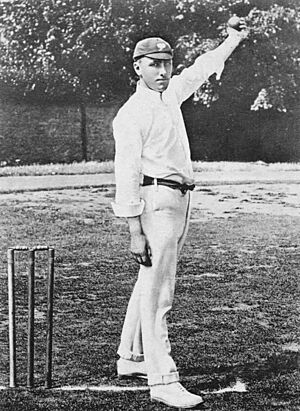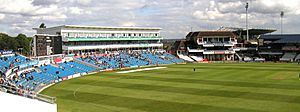Yorkshire County Cricket Club facts for kids
 |
|
| Personnel | |
|---|---|
| Captain | Jonny Bairstow Dawid Malan (T20) |
| Coach | Anthony McGrath |
| Overseas player(s) | Abdullah Shafique Jordan Buckingham Imam-ul-Haq Ben Sears Will Sutherland Will O'Rourke (T20) |
| Chief executive | Sanjay Patel |
| Team information | |
| Founded | 1863 |
| Home ground | Headingley Cricket Ground, Leeds |
| Capacity | 18,350 |
| History | |
| First-class debut | Surrey in 1863 at The Oval |
| Championship wins | 33 (including 1 shared) |
| Pro40 wins | 1 |
| FP Trophy wins | 3 |
| Twenty20 Cup wins | 0 |
| B&H Cup wins | 1 |
| Official website | www.yorkshireccc.com |
Yorkshire County Cricket Club is a professional cricket team from Yorkshire, England. They play in the top English cricket leagues, including the County Championship, T20 Blast, and One-Day Cup. Yorkshire is the most successful team in English cricket history. They have won the County Championship 33 times, including one shared title. Their most recent Championship win was in 2015.
The club's limited-overs team was once called Yorkshire Carnegie. From 2013, they became known as the Yorkshire Vikings. For the 2025 season, all of the club's men's and women's teams are competing under the single Yorkshire name, with an added 'Rose' symbol.
The team's traditional colors are Cambridge blue, Oxford blue, and Old Gold. They play most of their home games at Headingley Cricket Ground in Leeds. Another important place they play is at North Marine Road Ground, Scarborough, which hosts the yearly Scarborough Festival.
Contents
How Cricket Started in Yorkshire
The first known mention of cricket in Yorkshire was in 1751. Local matches were played in Sheffield, and a game took place near Richmond. The Sheffield Cricket Club was likely formed around this time. They played matches against teams from Leeds and Nottingham.
Cricket became more popular after a special match in 1827. This game, played in Sheffield, tested a new way of roundarm bowling. After this, many new cricket clubs started in Yorkshire.
In 1833, the name "Yorkshire" was first used for a team. This team played against Norfolk. The name "Yorkshire" helped the team match the status of other county teams. For the next 30 years, the Yorkshire team played sometimes but was not formally organized.
Yorkshire County Cricket Club's Journey
Forming the Club
On January 8, 1863, the Yorkshire County Cricket Club was officially formed. Before this, a committee had tried to organize county matches. The new club allowed anyone to join for a small fee. Like many clubs back then, Yorkshire got money from wealthy supporters. Players were professionals and were paid for each match.
The first club President was Michael Ellison. Joseph ("J. B.") Wostinholm became the first club Secretary in 1864. The first team captain was Roger Iddison, a professional player. The club wanted to play matches across Yorkshire, not just in Sheffield.
Early Years: 1863–1882
Yorkshire played its first official match against Surrey in June 1863. They drew that game but won their next match against Nottinghamshire. In their first season, they won two out of four matches.
In 1865, some players, including Captain Roger Iddison, refused to play against Surrey. This was due to a disagreement about how bowlers could throw the ball. Because important players were missing, Yorkshire did not win any games in 1865. The issue was resolved by 1867, and the players apologized.
After the dispute, Yorkshire had a great year in 1867, winning all seven of their matches. The sports newspapers called them the "Champion County" for the first time. In 1868, John Thewlis scored the first century (100 runs) for Yorkshire. The team was very successful in these years, thanks to bowlers George Freeman and Tom Emmett.
After 1870, Yorkshire's performance dropped. They tried to find new young players. In 1873, rules were set for players to be eligible for county teams. This helped make county cricket more organized.
Despite having good players like Ephraim Lockwood, Yorkshire struggled in the mid-1870s. They finished near the bottom in 1877. Tom Emmett became captain, but the team was inconsistent. Reports suggested that players sometimes had issues off the field. However, the club became more successful financially. They improved their home ground and paid players better.
In 1881, Yorkshire finished second in the unofficial Championship. A new player, Lord Hawke, joined the team at age 21. In 1882, Hawke became the team captain. He was the first amateur (non-professional) player to lead the team. He stayed in charge for 28 seasons until 1910. During his time, the team won eight County Championships.
Hawke's Leadership: 1883–1918
Lord Hawke was known for his strong leadership. He helped unite the team and make it one of the best in England. He focused on teamwork and discipline.
Yorkshire won their first official County Championship in 1893. They continued to improve with players like Jack Brown, David Hunter, Stanley Jackson, and Bobby Peel. Later, John Tunnicliffe, David Denton, Ted Wainwright, and George Hirst joined. Hawke also started paying professional players during the winter.
In 1897, Bobby Peel left the team. He was replaced by Wilfred Rhodes in 1898, who took many wickets in his first season. In the same year, Brown and Tunnicliffe set a record for the highest opening partnership, scoring 554 runs. Yorkshire won their third Championship in 1898.
Between 1900 and 1902, Yorkshire won the County Championship three times in a row. This was largely due to their amazing all-rounders, Hirst and Rhodes. The club's offices moved from Sheffield to Leeds. The club also improved player contracts, offering better pay and bonuses.
Yorkshire remained a strong team until the First World War. They won three more titles between 1903 and 1914. In 1906, George Hirst achieved a unique feat by scoring over 2,000 runs and taking over 200 wickets in one season. Lord Hawke stepped down as captain in 1910.
Dominance and Rivalries: 1919–1970
Yorkshire won the first Championship after the war in 1919. They continued to be a very strong team until the Second World War. They won every year from 1922 to 1925 and seven more times in the 1930s.
Yorkshire's biggest rivalry is with Lancashire. This rivalry was especially strong between the two World Wars. During this time, Yorkshire and Lancashire were the best teams in English cricket.
Wilfred Rhodes retired in 1930 at the age of 53. He was replaced by Hedley Verity, another skilled bowler. In 1932, Verity achieved an incredible bowling feat, taking ten wickets for only ten runs in a match. Also in 1932, Percy Holmes and Herbert Sutcliffe set a record opening partnership of 555 runs. Len Hutton, who became a famous batsman, started his career in the 1930s.
After the Second World War, many people came to watch cricket. Yorkshire won the first post-war Championship in 1946. New players like Johnny Wardle, Brian Close, and Fred Trueman joined the team. The 1950s were dominated by another team, Surrey. However, Yorkshire won the title again in 1959 under Captain Ronnie Burnet.
The 1960s saw a new Yorkshire team that was very successful. Brian Close became captain in 1963 and led them to win the Championship in his first season. The team included famous players like Fred Trueman, Ray Illingworth, and Geoffrey Boycott. They won three championships in a row, ending in 1968. Brian Close was removed as captain in 1970.
Challenges and Changes: 1971–2000
After 1970, the club faced some challenges. In 1973, Bramall Lane, the club's original home ground, stopped hosting cricket matches. It became a football stadium.
Geoffrey Boycott captained Yorkshire for most of the 1970s, but the team did not win many titles. He was removed as captain in 1978. Ray Illingworth returned to the club as team manager. In 1982, at age 50, he became captain. Yorkshire finished last in the County Championship for the first time in 1983. However, they won the John Player League that year.
From 1968 to 1992, Yorkshire had a rule that only players born within Yorkshire could play for the team. This put them at a disadvantage because other teams could sign international players. In 1992, this rule was changed. It allowed players who had been educated in Yorkshire to play. Later, the rule was removed completely. Yorkshire's first international player from overseas was 19-year-old Sachin Tendulkar.
Recent Years: 2001 to Present
Yorkshire finally won the County Championship again in 2001, led by Captain David Byas. The club had mixed success in the early 2000s. In 2010, they finished third in the Championship under Andrew Gale.
For many years, there were concerns about players from Yorkshire's diverse communities not getting opportunities at the club. While Tendulkar was the first Asian player, he was from overseas. In 2003, Ismail Dawood became the first British-born Asian player for Yorkshire. He was followed by Ajmal Shahzad and Adil Rashid, who have both played for England. In 2007, Azeem Rafiq became the first player of Asian background to captain an England team (U-15). In 2012, Rafiq became the first player of Asian origin to captain the county team and the youngest captain in the club's history.
The club was moved down a division at the end of the 2011 season. This led to big changes in the coaching staff. Former player Jason Gillespie became the new coach. After quickly getting promoted back up, Gillespie helped the team challenge for the title in 2013, finishing second. Yorkshire then won the title in both 2014 and 2015.
Team Badge and Colors
Lord Hawke designed the club's white rose badge. He wanted it to be different from Lancashire's red rose. His design has eleven petals, representing the eleven players on the team. Only players who had received their special "county cap" were allowed to wear the badge. In the 1980s, the club started putting the design on merchandise for fans. Yorkshire's club colors are dark blue, light blue, and gold. These colors are seen on the players' sweaters.
Home Grounds
Yorkshire County Cricket Club represents the historic county of Yorkshire. The club was founded in 1863 in Sheffield and was first based at Bramall Lane.
Yorkshire first played at North Marine Road, Scarborough in 1878. This ground still hosts the yearly Scarborough Festival matches. Headingley Cricket Ground was first used in 1888. Test cricket (international matches) started there in 1899. The club's main office moved to Headingley in 1891. Other grounds in Hull, Sheffield, Bradford, Middlesbrough, and Harrogate were also used until the 1970s.
In 2005, Yorkshire bought the Headingley cricket ground. This helped ensure that Test cricket would continue to be played there. In 2006, the stadium was renamed Headingley Carnegie Stadium due to sponsorship. The club also announced plans to improve the stadium with more seats and new facilities.
Club Leadership and Support
The club is owned by its members, who elect officials. Until 2002, a general committee ran the club. Now, a board of management, led by a chief executive, is in charge. The role of club President still exists. Like all county clubs, Yorkshire gets a lot of support from sponsors.
Club Captains
Four Yorkshire players – Stanley Jackson, Len Hutton, Ray Illingworth, and Michael Vaughan – have captained England to win The Ashes. However, none of them were the club captain for Yorkshire at that exact time.
From 1883 to 1959, Yorkshire always had an amateur (non-professional) club captain. Lord Hawke once said in 1925 that he hoped a professional would never captain England. Despite this, in 1927, there was a discussion about Herbert Sutcliffe becoming Yorkshire captain, but it did not happen.
In 1960, Vic Wilson became Yorkshire's first professional captain since Tom Emmett. Brian Close, who took over in 1963, has been Yorkshire's most successful professional captain, winning four County Championships.
Honours and Achievements
First Team Wins
- County Championship (33 titles) – 1893, 1896, 1898, 1900, 1901, 1902, 1905, 1908, 1912, 1919, 1922, 1923, 1924, 1925, 1931, 1932, 1933, 1935, 1937, 1938, 1939, 1946, 1949 (shared), 1959, 1960, 1962, 1963, 1966, 1967, 1968, 2001, 2014, 2015
- FP Trophy (3 titles) – 1965, 1969, 2002
- National League (1 title) – 1983
- Benson & Hedges Cup (1 title) – 1987
Second Team Wins
- Second XI Championship (6 titles) – 1977, 1984, 1987 (shared), 1991, 2003, 2022
- Second XI Trophy (2 titles) – 2009, 2017
- Minor Counties Championship (5 titles) – 1947, 1957, 1958, 1968, 1971
See also
 In Spanish: Yorkshire County Cricket Club para niños
In Spanish: Yorkshire County Cricket Club para niños








